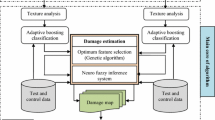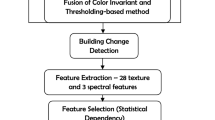Abstract
An accurate earthquake-induced damage assessment from very high resolution satellite images requires a joint use of spectral and spatial information. The spatial relations between pixels in damaged areas should properly be included in the classification model in order to exploit the spatial information. Morphological Profiles (MPs) and Attribute Profiles (APs) are the state-of-the-art image processing methods that produce a set of filtered images, which are able to highlight specific patterns representing a specific land cover class. In this study, the MPs and the APs are used to create additional spatial features for two different very high resolution post-event satellite images, acquired from the City of Bam in Iran and the City of Port-au-Prince in Haiti. These contextual features are then analyzed by means of a feature selection algorithm, called Minimum Redundancy Maximum Relevance, to find the most relevant features contributing the damage class the most. A final feature subset of selected features is analyzed using two different classifiers, which are k-nearest neighbors and support-vector machines. The results show that the use of a proper configuration of those profiles can significantly improve the classification accuracy and the quality of the thematic map, but generalization of the classification model is limited especially for the larger areas.


















Similar content being viewed by others
Notes
The authors are grateful to ITU Research and Application Center for Satellite Communications and Remote Sensing (CSCRS) for providing the pre- and post-earthquake QuickBird images covering the Port-au-Prince study area.
References
Fabio Dell’Acqua, Paolo Gamba (2012) Remote sensing and earthquake damage assessment: experiences, limits, and perspectives. Proc IEEE 100(10):2876–2890
Geiß Christian, Taubenböck Hannes (2013) Remote sensing contributing to assess earthquake risk: from a literature review towards a roadmap. Nat Hazards 68(1):7–48
Dong Laigen, Shan Jie (2013) A comprehensive review of earthquake-induced building damage detection with remote sensing techniques. ISPRS J Photogramm Remote Sens 84:85–99
Mitomi H, Matsuoka M, Yamazaki F (2002) Application of automated damage detection of buildings due to earthquakes by panchromatic television images. In: The 7th US National Conference on Earthquake Engineering, CD-ROM, pp 10
Samadzadegan F, Rastiveisi H, VIII WG, (2008) Automatic detection and classification of damaged buildings, using high resolution satellite imagery and vector data. Int Arch Photogrammetry Remote Sens Spat. Inf Sci 37(Part:B8):415–420
Dubois D, Lepage R (2014) Fast and efficient evaluation of building damage from very high resolution optical satellite images. IEEE J Sel Top Appl Earth Obs Remote Sen 7(10):4167–4176
Rathje EM, Crawford M, Woo K, Neuenschwander A (2005) Damage patterns from satellite images of the 2003 bam, Iran, earthquake. Earthq Spectra 21(S1):295–307
Sun W, Shi L, Yang J, Li P (2016) Building collapse assessment in urban areas using texture information from postevent sar data. IEEE J Sel Top Appl Earth Obs Remote Sens 9(8):3792–3808
Pesaresi M, Benediktsson JA (2001) A new approach for the morphological segmentation of high-resolution satellite imagery. IEEE Trans Geosci Remote Sens 39(2):309–320
Benediktsson JA, Pesaresi M, Amason K (2003) Classification and feature extraction for remote sensing images from urban areas based on morphological transformations. IEEE Trans Geosci Remote Sens 41(9):1940–1949
Huang X, Zhang L (2012) Morphological building/shadow index for building extraction from high-resolution imagery over urban areas. IEEE J Sel Top Appl Earth Obs Remote Sens 5(1):161–172
Chini M, Pierdicca N, Emery WJ (2009) Exploiting SAR and VHR optical images to quantify damage caused by the 2003 bam earthquake. IEEE Trans Geosci Remote Sens 47(1):145–152
Parape CD, Tamura M (2011) Identifying damaged buildings from high-resolution satellite imagery in hazardous areas using morphological operators. In: 2011 IEEE International Geoscience and Remote Sensing Symposium, pp 1898–1901
Dell’Acqua F, Bignami C, Chini M, Lisini G, Polli DA, Stramondo S (2011) Earthquake damages rapid mapping by satellite remote sensing data: L’aquila april 6th, 2009 event. IEEE J Sel Top Appl Earth Obs Remote Sens 4(4):935–943
Wang Jianhua, Qin Qiming, Zhao Jianghua, Ye Xin, Feng Xiao, Qin Xuebin, Yang Xiucheng (2015) Knowledge-based detection and assessment of damaged roads using post-disaster high-resolution remote sensing image. Remote Sens 7(4):4948–4967
Li L, Li Z, Zhang R, Ma J, Lei L (2010) Collapsed buildings extraction using morphological profiles and texture statistics - a case study in the 5.12 wenchuan earthquake. In: 2010 IEEE International Geoscience and Remote Sensing Symposium, pp 2000–2002
Dalla Mura M, Benediktsson JA, Bruzzone L (2009) Modeling structural information for building extraction with morphological attribute filters. Image Signal Process Remote Sens XV 7477:747703
Keinosuke Fukunaga (1990) Chapter 10 - feature extraction and linear mapping for classification. In: Fukunaga Keinosuke (ed) Introduction to statistical pattern recognition, 2nd edn. Academic Press, Boston, pp 441–507
Pedergnana Mattia, Marpu Prashanth Reddy, Mura Mauro Dalla, Benediktsson Jón Atli, Bruzzone Lorenzo (2013) A novel technique for optimal feature selection in attribute profiles based on genetic algorithms. IEEE Trans Geosci Remote Sens 51(6):3514–3528
Haralick RM, Sternberg SR, Zhuang X (1987) Image analysis using mathematical morphology. IEEE Trans Pattern Anal Mach Intell PAMI 9(4):532–550
DallaMura M, Benediktsson J et al (2010) Morphological attribute profiles for the analysis of very high resolution images. IEEE Trans Geosci Remote Sens 48(10):3747–3762
Breen EJ, Jones R (1996) Attribute openings, thinnings, and granulometries. Comput Vis Image Underst 64(3):377–389
Dalla Mura Mauro, Benediktsson Jon Atli, Chanussot Jocelyn, Bruzzone Lorenzo (2011) The evolution of the morphological profile: from panchromatic to hyperspectral images. In: Prasad S, Bruce LM, Chanussot J (eds) Optical remote sensing: advances in signal processing and exploitation techniques, vol 3 , Augmented Vision and Reality, pp 123–146
Hanchuan Peng, Fuhui Long (2005) Ding C, Feature selection based on mutual information criteria of max-dependency, max-relevance, and min-redundancy. IEEE Trans Pattern Anal Mach Intell 27(8):1226–1238
Ghassemian Hassan (2016) A review of remote sensing image fusion methods. Inf Fusion 32:75–89
Landgrebe David, Biehl Larry (2002) Multispec. Purdue University, https://engineering. purdue. edu/\(\tilde{\,\,}\)biehl/MultiSpec/hyperspectral. html. (10 August 2017), 2002
Alataş EO, Taşkín G (2019) Attribute profiles in earthquake damage identification from very high resolution post event image. In: IGARSS 2019 - 2019 IEEE International Geoscience and Remote Sensing Symposium, pp 9299–9302
Phan Thanh Noi, Martin Kappas (2017) Comparison of random forest, k-nearest neighbor, and support vector machine classifiers for land cover classification using sentinel-2 imagery. Sensors 18(2):18
European Space Agency (2004) Charter map of bam earthquake damage [Damage zonation map]. ESA. https://www.esa.int/ESA_Multimedia/Images/2004/06/Charter_map_of_Bam_earthquake_damage
European Space Agency (2010) Damage around port-au-prince, Haiti [Damage zonation map]. ESA. https://www.esa.int/ESA_Multimedia/Images/2010/01/Damage_around_Port-au-Prince_Haiti
Author information
Authors and Affiliations
Corresponding author
Ethics declarations
Conflicts of interest
The authors have no conflicts of interest to declare that are relevant to the content of this article.
Additional information
Publisher's Note
Springer Nature remains neutral with regard to jurisdictional claims in published maps and institutional affiliations.
Rights and permissions
About this article
Cite this article
Alataş, E.O., Taşkın, G. An earthquake damage identification approach from VHR image using mathematical morphology and machine learning. Neural Comput & Applic 34, 18757–18771 (2022). https://doi.org/10.1007/s00521-022-07452-6
Received:
Accepted:
Published:
Issue Date:
DOI: https://doi.org/10.1007/s00521-022-07452-6




